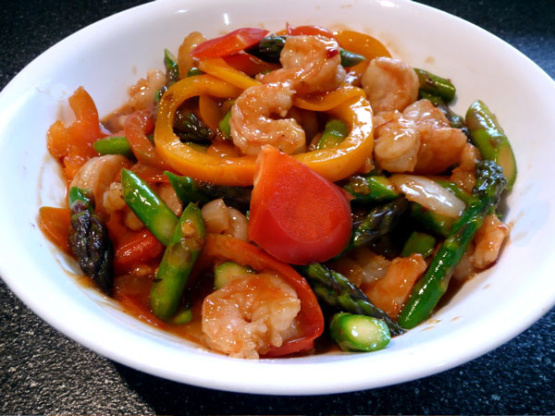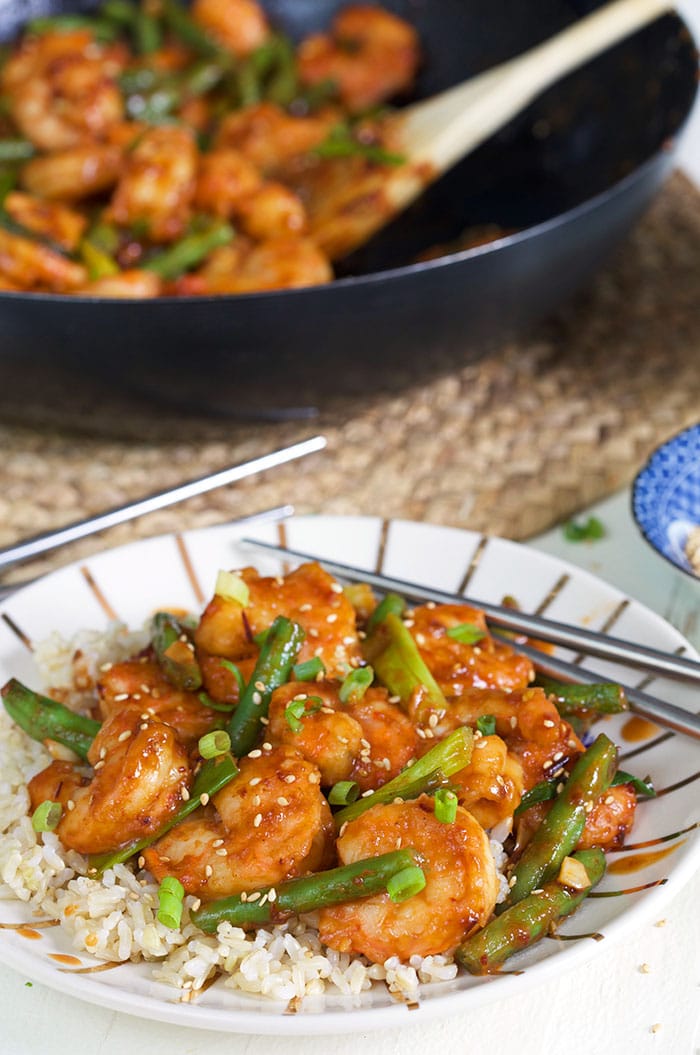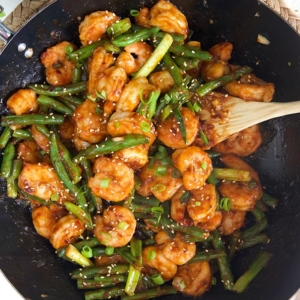Quick and easy Hunan Shrimp recipe is the ultimate take out fake out. In just 10 minutes, you can have dinner made with spicy shrimp and vegetables stir-fried in a magic sauce.
Once school starts, things start to get hectic around here and dinnertime can easily fall apart. It’s easy to get takeout, but sometimes it’s just as quick to make dinner at home.
A great way to quickly make dinner is to stir fry, and this Hunan Shrimp recipe is even faster than delivery.
Hunan Shrimp is a dish that’s commonly found on American Chinese menus. The flavor is very similar to this Shrimp Mei Fun I shared before and is super popular.
One of the Eight Great Traditions of Chinese food is Hunan cuisine, which is also called Xiang cuisine. It is famous for its hot and spicy flavors, strong smells, and bright colors.
In a spicy sauce made of chili bean paste, garlic, soy sauce, and rice vinegar, soft shrimp are cooked. Served with green beans and green onions, you can really add any additional vegetables you have on hand.
Shrimp – You can use fresh or frozen (thawed) shrimp for this recipe. I like to buy it already peeled and deveined to save some prep time.
Cornstarch – Cornstarch is used to get a crispy coating on your shrimp. It also helps the sauce stick to the shrimp giving each bite a spicy burst of flavor.
Green Beans – I like to use fresh green beans for this recipe. Frozen will work, too, but they won’t get the charred, blistered skin you get from fresh beans. They also stay somewhat crisp once cooked. You can also use snow peas, broccoli and edamame, if you prefer.
You can leave out the green onions if you don’t want to. They’re pretty common in stir-fry recipes around here.
Chili Paste—In a lot of our takeout-inspired recipes, we use chili paste, which is also called Doubanjiang. It’s simple to find at most grocery stores and a great way to spice things up.
Oyster Sauce – Oyster sauce is a rich sauce made from boiled oysters and seasonings. It doesn’t taste fishy at all and adds a nice depth of flavor to your sauce.
Soy Sauce – Soy sauce adds a great salty note with a deep, rich flavor. You can also use Tamari for a gluten free option.
Rice Wine Vinegar – Adds a great tangy flavor to the sauce with a subtle sweetness. If you can’t find Rice Vinegar, you can substitute it with Apple Cider Vinegar.
Hunan shrimp has become a ubiquitous menu item at Chinese restaurants across America. Its spicy, savory flavor profile makes it an irresistible choice for shrimp lovers. But what exactly is in this peppy stir-fry? Let’s take a closer look at the vegetal components that make hunan shrimp such a hit.
A Brief History of Hunan Shrimp
While hunan shrimp as we know it today traces its roots to Hunan province in China, the version served at American Chinese restaurants is a uniquely Chinese-American creation. Hunan cuisine is known for its liberal use of chili peppers, garlic, and other bold seasonings.
When the dish made its way onto menus in the States, traditional ingredients like bok choy and wood ear mushrooms were replaced with more familiar veggies like green beans and onions. The complex flavor profile remained, but the ingredient list got a major simplification.
Over time hunan shrimp became a staple that diners expect to find at just about any Chinese restaurant in America. It strikes the perfect balance between sweet, spicy salty, and umami.
So what exactly is in the veggie component of this iconic stir-fry? Let’s find out!
Green Beans Are The Vegetable Star
The most predominant vegetable in American-style hunan shrimp is green beans. Their crunchy texture and verdant color provide the perfect contrast to the tender shrimp and lustrous red sauce.
Green beans have a more mild, vegetal flavor than leafy greens like bok choy. This allows the other components of the dish to shine.
In addition to color and texture, green beans pack a nutritional punch. Just a half cup contains 2 grams of fiber. They also provide Vitamin C, Vitamin K, folate, and manganese.
Some versions of the dish use snap peas or even broccoli instead of or in addition to green beans. But the most authentic take on American hunan shrimp calls for crisp, fresh green beans.
Onions Add Aromatic Depth
While the green beans provide the bulk of the vegetable heft in hunan shrimp, onions play an important supporting role. Green onions are most commonly used for their bright, concentrated flavor.
The white portions have an earthy onion punch, while the green tops contribute a fresh, grassy aroma. This combo brightens up the sauce and complements the other ingredients beautifully.
Yellow, white, or even red onions can also be used. Their crunch and sweetness balance out the spice from the chili paste in the sauce.
Onions are rich in in compounds called flavonoids, which have impressive antioxidant properties. They also contain Vitamin C and manganese.
Garlic: Aromatic and Medicinal
No savory stir-fry would be complete without the presence of garlic. In hunan shrimp, it adds an aromatic grassiness that enhances the flavor of the sauce exponentially.
Garlic is chock full of a compound called allicin. It’s what gives garlic its pungent smell and flavor. Allicin also has scientifically-proven medicinal properties. It acts as a powerful antioxidant and has antimicrobial effects.
Garlic also contains manganese, Vitamin C, Vitamin B6, selenium, and fiber. It packs a mighty nutritional punch for such a tiny ingredient.
Clearly, the vegetables in hunan shrimp do more than just bulk up the dish. They provide complex flavors, textures, colors, and an array of nutritional benefits.
Veggie Variations Keep Things Interesting
One of the great things about hunan shrimp is that it lends itself to improvisation. As long as you have those iconic chilies and aromatics, you can swap in just about any veggie you happen to have on hand.
Some delicious options include:
- Snow peas – tender and sweet
- Water chestnuts – crunchy and juicy
- Mushrooms – meaty and umami-rich
- Baby corn – a fun, cute addition
- Bell peppers – for additional color and flavor
- Baby bok choy – for authentic Chinese flavor
You can also increase the amount of onions or garlic to really amplify their impact. Or add both chili paste and fresh chopped chilies for extra heat.
Hunan shrimp is all about big, bold flavors. So don’t be shy with your veggie additions. As long as you maintain the basic formula, feel free to get creative.
Sauce Ingredients Also Pack Nutritional Perks
It’s not just the veggies that are healthy in hunan shrimp. Many elements of the signature sauce boast impressive nutritional profiles as well.
Soy sauce is rich in antioxidants, has anti-cancer properties, and is high in bone-healthy minerals. It also contains the probiotic bacteria Weisella.
Rice vinegar aids digestion, helps manage blood sugar levels, and contains vitamins and minerals like magnesium, iron, and potassium.
Chili paste contains capsaicin, which has anti-inflammatory effects. It may also boost metabolism.
Ginger can ease nausea, reduce pain, lower blood sugar, and decrease inflammation.
Garlic (yes, it goes in the sauce too!) provides the same benefits listed for the veggie component.
So the vegetables aren’t the only healthy aspect of hunan shrimp. The sauce delivers major nutritional value as well.
Achieve Veggie Balance
At the end of the day, hunan shrimp is all about achieving flavor and textural balance. You want tender shrimp contrasted by crisp-tender vegetables enveloped in a complex, spicy sauce.
Aim for 1 to 2 cups of chopped vegetables for every pound of shrimp. Green beans should make up the bulk of this veggie mix.
Onions, garlic, and any other additions are just seasoning agents. A little goes a long way, so stick to 1/4 to 1/2 cup total of the aromatics.
If you choose to add mushrooms, bell peppers, or other veggies, do so sparingly to avoid overwhelming the green beans.
Hunan shrimp is all about simplicity. A small handful of humble vegetables can transform shrimp into a restaurant-worthy meal with the right saucy preparation.
Enjoy An American Classic
Hunan shrimp has come a long way from its origins in a landlocked province in China. It has morphed into a fixture on Chinese restaurant menus across America.
The genius combination of tender shrimp, crisp beans, pungent aromatics, and a sweet-spicy sauce keep diners coming back for more.
Its popularity is well-deserved. Hunan shrimp is affordable, easy to make, highly customizable, and craveably delicious.
So the next time you are asked, “What vegetables are in hunan shrimp?” You’ll have the knowledge to provide a detailed response about this classic Chinese-American staple.

HOW TO MAKE HUNAN SHRIMP
Because you’re stir-frying your recipe, the cooking process moves along quickly. So, be sure to have your ingredients prepped and ready to go so you don’t overcook anything.
Mix the garlic, chili paste, oyster sauce, soy sauce, rice wine vinegar, chicken stock, and rice wine vinegar in a bowl.
Toss the shrimp in the cornstarch to coat.
Heat the oil in a large skillet or wok.
Cook the shrimp by stir-frying for 2-3 minutes. Remove the shrimp from the pan.
Cook the green beans, adding more oil to the pan if needed. Stir in the green onions.
Return the shrimp to the pan.
Stir in the sauce cooking for 2-3 minutes or until slightly thickened.
Sprinkle with sesame seeds and serve over rice.
That’s it! How easy is that???
If you don’t want shrimp tonight, you can easily switch out the shrimp for chicken in this simple Hunan Chicken recipe.

MORE TAKE OUT RECIPES
If you love this Hunan Shrimp, you should also try this easy Mongolian Beef recipe. It’s slightly spicy but a total favorite with my whole family…. even the little guy who doesn’t like spicy food.
If you want to add a spicy side…these easy Dan Dan Noodles are our favorite!

